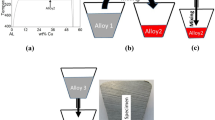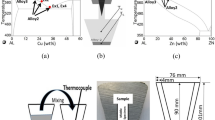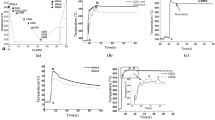Abstract
Controlled diffusion solidification (CDS) is a casting process that depends on mixing two precursor alloys to make a required resultant alloy. The CDS process can form a non-dendritic microstructure happening from copious nucleation, resulting in minimizing the tendency toward hot tearing. Pure aluminum was mixed into Al-33wt%Cu through funnels that have 9 and 6 mm diameters to make Al-4.7wt%Cu. Ansys software was employed to simulate the temperature, density, and velocity redistribution in the mixture during the mixing step. The results show that the thermal curves give better indications to predict the periods of nucleation and the heat transferring to the environment. Furthermore, the copious nucleation that occurs in the CDS process can be improved by controlling the agitation during the mixing step by decreasing the velocity of the mixture near the crucible wall and increasing the velocity in the middle of the mixture. The velocity around 1.7 ms−1 and 0.2 ms−1 happening at the middle and near crucible wall, respectively, gives better non-dendritic microstructure.







taken from the lower thermocouple for the experiment named Ex6 to Ex8 involved in Table 1, a thermal curve for Ex6, b thermal curve for Ex7, and c thermal curve for Ex8



Similar content being viewed by others
Availability of data and materials
The experimental and simulation data are transparent.
Notes
NIKON AZ 100 M is a trademark of Eberbach Corporation, Ann Arbor, MI.
Ansys 15, Ansys Inc.
Abbreviations
- Alloy1:
-
Precursor alloys
- Alloy2:
-
Precursor alloys
- Alloy3:
-
Resultant desired alloy
- CCu :
-
Copper concentration wt%
- Co :
-
Alloy3 concentration wt%
- CP :
-
Specific heat of liquid (J kg−1 K−1)
- K:
-
Liquid thermal conductivity (W m−1 C−1)
- m1:
-
Mass of alloy1
- m2:
-
Mass of alloy2
- mr:
-
Mass ratio (m1/m2)
- p:
-
Pressure (Mpa)
- T:
-
Actual temperature (K)
- T1 :
-
Alloy1 temperature (K)
- T2 :
-
Alloy2 temperature (K)
- TC :
-
Minimum temperature (K)
- Tm :
-
Melting temperature of pure metal (K)
- TLiq :
-
Liquidus temperature (K)
- ΔT:
-
Undercooling below liquidus temperatures (K)
- t:
-
Time (s)
- tm :
-
Time of starting of mixing (s)
- u:
-
Velocity (ms−1)
- ρ:
-
Liquid density (kg m−3)
- βT :
-
Coefficient of thermal expansion
- βC :
-
Coefficient of solute expansion
- µ:
-
Viscosity (mPa)
References
Fan Z, Fang X, Ji S (2005) Microstructure and mechanical properties of rheo-diecast (RDC) aluminium alloys. Mater Sci Eng A 412:298–306
Schmitz J, Brillo J, Egry I, Schmid-Fetzer R (2009) Surface tension of liquid Al-Cu binary alloys. Int J Mater Res 100:1529–1535. https://doi.org/10.3139/146.110221
Li S, Apelian D, Sadayappan K (2011) Hot Tearing in Cast Aluminum Alloys. Mater Sci Forum 690:355–358. https://doi.org/10.4028/www.scientific.net/MSF.690.355
Rappaz M, Drezet J-M, Gremaud M (1999) A new hot-tearing criterion. Metall Mater Trans A 30:449–455
Saha D, Shankar S, Apelian D, Makhlouf MM (2004) Casting of aluminum-based wrought alloys using controlled diffusion solidification. Metall Mater Trans A 35:2174–2180. https://doi.org/10.1007/s11661-004-0167-8
Khalaf AA (2016) Mechanism of controlled diffusion solidification: Mixing, nucleation and growth. Acta Mater 103:301–310
Khalaf AA, Ashtari P, Shankar S (2009) Controlled Diffusion Solidification ( CDS ): Conditions for Non-Dendritic Primary Aluminum Phase in Al-Cu Hypo-Eutectic Alloys. In: The Third International Symposium, TMS (The Minerals, Metals & Materials Society). pp 215–222
Khalaf AA (2010) Controlled diffusion solidification: process mechanism and parameter study. Ph.D Thesis. McMaster University
Khalaf AA, Ashtari P, Shankar S (2009) Formation of nondendritic primary aluminum phase in hypoeutectic alloys in controlled diffusion solidification (CDS): A hypothesis. Metall Mater Trans B 40:843–849
Khalaf AA, Shankar S (2011) Favorable environment for a nondendritic morphology in controlled diffusion solidification. Metall Mater Trans A 42:2456–2465
Khalaf AA, Shankar S (2012) Effect of mixing rate on the morphology of primary Al phase in the controlled diffusion solidification (CDS) process. J Mater Sci 47:8153–8166
Apelian D, Makhlouf MM, Saha D (2006) CDS Method for Casting Aluminium-Based Wrought Alloy Compositions: Theoretical Framework. In: Materials Science Forum. pp 1771–1776
Symeonidis K (2009) The controlled diffusion solidification process: fundamentals and principles.Ph.D Thesis. Worcester Polytechnic Institute (WPI)
Ghiaasiaan R, Zeng X, Shankar S (2014) Controlled Diffusion Solidification (CDS) of Al-Zn-Mg-Cu (7050): Microstructure, heat treatment and mechanical properties. Mater Sci Eng A 594:260–277
Pourgharibshahi M, Divandari M, Saghafian Larijani H, Ashtari P (2017) Controlled diffusion solidification processing: A review. J Mater Process Technol 250:203–219. https://doi.org/10.1016/j.jmatprotec.2017.07.018
Yang X, Li YD, Luo XM, Zhou HW, Cai QY, Li M, Ma Y (2019) Microstructural evaluation and mechanical properties of 7075 aluminum alloy prepared by controlled diffusion solidification. China Foundry 16:238–247. https://doi.org/10.1007/s41230-019-9059-9
Ghiaasiaan R, Shankar S (2020) Microstructure, intermetallic phases, and fractography of the cast Al-5.8Zn-2.2Mg-2.5Cu alloy by controlled diffusion solidification. Metall Mater Trans A Phys Metall Mater Sci 51:4711–4726. https://doi.org/10.1007/s11661-020-05885-z
Khalaf AA (2021) Studying of non-dendritic microstructure forming in controlled diffusion solidification. Int J Met. https://doi.org/10.1007/s40962-021-00590-y
Khalaf AA, Shankar S (2020) Mechanism of anomalous grain formation during controlled diffusion solidification. JOM. https://doi.org/10.1007/s11837-020-04198-1
Khalaf AA (2022) Metastable transition temperature in undercooled hypereutectic Al-Si alloys. Scr Mater 210:
Khalaf A (2022) Microstructure evolution of Al-Si hypoeutectic alloys prepared by controlled diffusion solidification. Int J Adv Manuf Technol 1–22. https://doi.org/10.1007/s00170-022-09075-6
Li Y, Zhang X, Ma Y et al (2015) Effect of mixing rate and temperature on primary Si phase of hypereutectic Al-20Si alloy during controlled diffusion solidification ( CDS ) process. China Foundry Res Dev 12:173–179
Khalaf AA, Takrouri KJ (2020) Spontaneous nucleation in hypoeutectic Al – Cu system by controlled diffusion solidification process. SN Appl Sci 2:1337
Wu M, Ludwig A (2009) Modeling equiaxed solidification with melt convection and grain sedimentation-II. Model verification Acta Mater 57:5632–5644. https://doi.org/10.1016/j.actamat.2009.07.067
Kurz W, Fisher DJ (1984) Fundamentals of Solidification, 2nd edn. Trans Tech Publications, Aedermannsdorf
Acknowledgements
The authors are grateful to Mr. Doug Culley, Mr. Xiaogang Li, and Xiaochun Zheng for assisting in this research project.
Author information
Authors and Affiliations
Contributions
AAK designed the study, performed the research, analyzed the data, wrote the paper, and conducted experiments and data processing.
Corresponding author
Ethics declarations
Ethics approval
This article does not contain any studies with human participants performed by any of the authors.
Consent to participate
This work was conducted with no human test subjects.
Consent for publication
This work has consent for publication.
Conflict of interest
The author declares no competing interests.
Additional information
Publisher's Note
Springer Nature remains neutral with regard to jurisdictional claims in published maps and institutional affiliations.
Rights and permissions
About this article
Cite this article
Khalaf, A.A. Temperature, density, and velocity distribution in the mixture prepared by controlled diffusion solidification process. Int J Adv Manuf Technol 121, 3857–3870 (2022). https://doi.org/10.1007/s00170-022-09564-8
Received:
Accepted:
Published:
Issue Date:
DOI: https://doi.org/10.1007/s00170-022-09564-8




